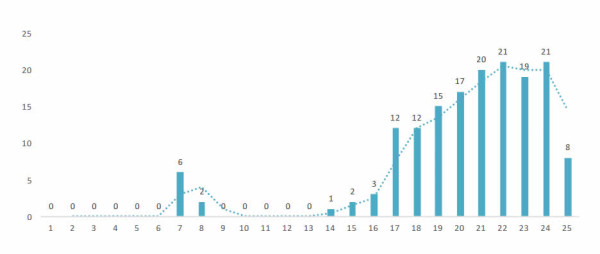I was planning a Costa Rica vacation for my extended family (3 years to 73 years old, none pregnant) in 2016 and wanted to know what risk the Zika virus posed. My PhD in Biochemistry doesn’t usually contribute directly to my current job as a travel writer, but in this case it provided me with the tools to locate and understand scientific articles about the disease and cut through the hysteria and just plain false information in the news and on social media.
Most Recent Update: (more updates)
Health Agencies have downgraded Zika in the Americas from an emergency to a chronic disease …read more…

What I Found Was Surprising
If you are trying to escape the Aedes mosquitoes that can transmit the zika virus you should leave New York, Chicago, Atlanta…in fact the entire United States east of the Rockies and much of California and southern Canada.
The map shown above is based on “the most up-to-date data on the known locations of the species combined with information on environmental conditions across the globe.” and remarkably but clearly shows a less appropriate habitat in Costa Rica than much of the U.S. for the Ae. Albopictus species mosquito. Ae. aegypti also transmits zika in the Americas and has a similar distribution map but a more southerly range.
The map does not show where the mosquitoes are, or where Zika is, just where the habitat is appropriate for the mosquitoes that carry it. Another map shows where traps have captured them across the U.S. While it indicates that some areas of the mid-west and north-east may not have Aedes mosquito populations they have been found as far north as New Hampshire and are surprisingly common in extremely dry areas like New Mexico, Arizona and California.
Zika is a serious health problem for fetuses especially in the first trimester but extremely low risk for healthy infants, children, adults or seniors.
You should consult your health professional and check out the CDC, WHO, BBC and other scientific facts before making your decision when and where to travel and how to protect yourself at home in the U.S. or Europe.
My family and I had a fantastic vacation and no-one caught anything.
UPDATE December 2, 2016 – Health agencies have downgraded Zika in the Americas from an emergency to a chronic disease.
As the rainy season draws to a close in Costa Rica the Zika threat never really materialized. A total of a couple of hundred mild cases in a year were massively overshadowed by tens of thousands of cases of Dengue.
UPDATE October 19, 2016 – Asian Tiger Mosquitoes have reached the UK. These are the first mosquitoes capable of transmitting Zika found in the U.K.
UPDATE September 19, 2016 – Miami’s Wynwood district the U.S. ground zero for mosquito transmission of Zika declared virus free.
UPDATE August 29, 2016 – A potential breakthrough for the treatment of Zika infections and prevention of microcephaly was reported today in one of the worlds leading scientific journals. Scientists from the U.S. National Institutes of Health, Johns Hopkins University and Florida State University reported discovering two existing drugs/compounds “that can both stop Zika from replicating in the body and from damaging the crucial fetal brain cells that lead to birth defects in newborns” in Nature: medicine.
One of the most exciting aspects of this discovery is that it’s possible it may lead to a viable treatment quite soon because one of the compounds is already approved and could shortcut the sometimes years long FDA approval process. According to FSU “One of the identified compounds is the basis for a drug called Nicolsamide, a U.S. Food and Drug Administration approved drug that showed no danger to pregnant women in animal studies. It is commonly used to treat tapeworm. This could theoretically be prescribed by a doctor today, though tests are still needed to determine a specific treatment regimen for the infection.”
UPDATE August 22, 2016 – A report in the Journal Stem Cell reports that “Zika Virus Infects Neural Progenitors in the Adult Mouse Brain and Alters Proliferation.” Some extremely irresponsible social media and “news” reports are suggesting that – this is proof of Zika causing brain damage in adult humans – which is false.
UPDATE August 16, 2016 – A baby with microcephaly was born in Costa Rica to a Nicaraguan mother who contracted Zika in Nicaragua before moving to Costa Rica. This has generated headlines like “Microcephaly in Costa Rica” which are misleading to say the least.
UPDATE July 29, 2016 – Cases of mosquito transmission have been reported in Miami Florida. The U.K. has issued an advisory for British citizens considering travel to the southern U.S. “Pregnant women are advised to consider postponing non-essential travel until after pregnancy.”
UPDATE July 10, 2016 – Still good news. The numbers of individuals infected so far in the rainy season has been much lower than many predictions. A North Dakota man was confirmed as the second case of U.S. tourist contracting Zika in Costa Rica out of approximately a million visitors since the outbreak began.

A total of 159 cases were detected in Costa Rica in the first half of 2016 including 6 pregnant women. Zero cases of Guillain-Barré syndrome, zero cases of any neurological complications and zero cases with any indication of microcephaly have been reported.
In the U.S. a total of 1,133 cases of Zika have been detected. Five cases of associated Guillain-Barré syndrome have been reported but no evidence of microcephaly has been seen.
UPDATE June 17, 2016 – Some good news. News reports indicate that the number of new cases of Zika in Central American countries has decreased over the past month indicating that even though the rainy season has arrived in the region the mosquito control efforts seem to be having a big positive impact in controlling the spread of the disease. The Costa Rican Ministry of Health reports a total of about 100 cases in 2016.
UPDATE May 30, 2016 – The Costa Rican Ministry of Health updated the total number of cases of Zika transmission to 58. 44 new cases in Jacó were added to the previously known 5 in San José and 9 on the Nicoya Peninsula. Mosquito eradication efforts are being increased but cases are expected to continue to rise as the Pacific and central mountain rainy season begins.
The number of travel related cases detected in the U.S. is up to 503 (see current CDC map). Over 150 pregnant women have tested positive for Zika in the U.S. Congress has now reversed course from blocking funding for Zika prevention and treatment in late 2015 to now recommending $1.1 billion in new funding.
UPDATE May 1, 2016 – The BBC published an announcement that there may be risks of other brain injuries to fetuses exposed to Zika.
UPDATE April 25, 2016 – Canada announced the first case of Zika and New York announced a $21 million plan to fight mosquitoes and the virus.
UPDATE April 13, 2016 – The CDC (U.S. Centers for Disease Control and Prevention) has cited a New England Journal of Medicine article stating “we suggest that sufficient evidence has accumulated to infer a causal relationship between prenatal Zika virus infection and microcephaly” to add Zika to the list of causes which previously included other infections during pregnancy, such as rubella, toxoplasmosis, or cytomegalovirus, alcohol or drug abuse, and malnutrition.
In other words the CDC has stated that Zika infections during pregnancy can be a cause of microcephaly. The CDC has not changed any of their recommendations based on this conclusion.
UPDATE April 12, 2016 – The CDC (U.S. Centers for Disease Control and Prevention) reports 346 cases across 41 states in the U.S. and active mosquito borne transmission in every country from Mexico south through the Caribbean and Central America to Ecuador, Columbia and Brazil in South America.
Republicans in Congress blocked 1.6 billion dollars in funding to fight Aedes mosquitoes and Zika and the White House announced that they would redirect $589 million in funds for Zika from existing Ebola funding.
The CDC says the data from their studies in Latin America should be analyzed by May 2016.
UPDATE April 10, 2016 – The CDC has changed it’s recommendation for pregnant women from “consider postponing” to “should not travel.”
“Zika virus can be spread from a pregnant woman to her fetus and has been linked to a serious birth defect of the brain called microcephaly in babies of mothers who had Zika virus while pregnant. Other problems have been detected among fetuses and infants infected with Zika virus before birth, such as absent or poorly developed brain structures, defects of the eye, hearing deficits, and impaired growth. CDC recommends special precautions for pregnant women. Women who are pregnant should not travel to areas with Zika. If you must travel to one of these areas, talk to your healthcare provider first and strictly follow steps to prevent mosquito bites during your trip.”
UPDATE March 25, 2016 – A baby in Panama is thought to be the first detected outside of Brazil with microcephaly and traces of zika “in the baby’s umbilical cord.” There was no evidence that Zika was present 7-9 months earlier in the first trimester when it’s theorized the virus might impact brain development and no evidence that Zika caused the microcephaly.
UPDATE March 15, 2016 – A retrospective statistical analysis in the British Medical journal the Lancet may have found 8 cases in the Polynesian outbreak of 2013
UPDATE February 28, 2016 – In a press release the U.S. government stated “As spring and summer approach, bringing with them larger and more active mosquito populations, we must be fully prepared to mitigate and quickly address local transmission within the continental U.S., particularly in the Southern United States.” Millions of dollars are being spent to eliminate mosquitoes and prepare the health system for the inevitable increase in U.S. cases. As of February 2016 two cases of sexual transmission had been detected in the U.S. The first was in 2008 and the second in Dallas Texas in 2016. There have also been more than 50 recent imported cases in the U.S. (caught zika in Brazil or elsewhere and got sick after returning home).
Recommendations For Avoiding Mosquito Bites At Home or When Traveling
The best time to visit Costa Rica to minimize your exposure to mosquitoes is the Pacific side dry season from January to April or the Caribbean side dry months of October and November.
Depending on where you’re coming from the risk of Zika may be lower in Costa Rica than it is where you live but that doesn’t mean you should be careless when you travel.
Of course we follow and strongly recommend the same preventative measures as the CDC, WHO and other health organizations.
- Choose a hotel or lodging with air conditioning or screens on windows and doors.
- Use a tested insect repellent like DEET or Picaridin and reapply as needed. Apply sunscreen first and repellent second.
- Most natural repellents (citronella oil, cedar oil, geranium oil, peppermint and peppermint oil) have never been proven effective.
- Wear long-sleeved shirts and long pants in areas where mosquitoes are present.
- Mosquitoes may bite through thin clothing. Treat clothes with permethrin or another Environmental Protection Agency (EPA)-registered insecticide for extra protection
If you’re concerned that the situation may worsen or that you may change your mind and cancel an upcoming trip we recommend investigating travel insurance. Although most travel insurance policies do not accept “I changed my mind” as justification for cancelling some do. However, airlines, hotels, resorts. tours and travel services almost never provide refunds.
Other Medical & Scientific Information on Zika
Mosquitoes are the deadliest animals on earth. Over a million people die every year from diseases carried by mosquitoes including Malaria, Chikungunya, Dengue, Yellow Fever, Encephalitis, and West Nile Virus. The diseases are not limited to the tropics – West Nile Virus ranges as far north as central Canada and has killed over 1,500 people in the U.S. alone. Despite the dramatic impact of photos of infants with microcephaly, the dangers of Zika pale in comparison to other mosquito transmitted diseases.
- Four out of five people who contract zika are asymptomatic – in other words 80% of the people who catch it never even know they have it.
- Zika is considered a very mild disease. Symptoms (when present at all) are mild headache, slight fever and sometimes red swollen eyes and lids, a rash, or joint pain.
- No vaccine or preventative drug is available
- Zika has been spreading since it was first seen in African monkeys in 1947 and has been recognized as a pandemic since 2007.
- According to the CDC, WHO, and several scientific publications, zika will almost certainly spread in transmission clusters across much of the U.S. in the summer of 2016 when the mosquito activity increases.
- Zika has been detected in six other species of mosquitoes but most of them are found only in Africa
- Guillain–Barré syndrome is a very rare autoimmune disease that usually causes temporary numbness and muscle weakness. Guillain–Barré may be triggered by the flu, influenza vaccines, respiratory or gastrointestinal bacterial infections. According to the WHO Zika also triggers Guillain–Barré syndrome in rare cases.
Recent History & the Micro-Cephaly Connection to Zika
In 2015 a connection between infant microcephaly and zika in expectant mothers was proposed by a Brazilian Government Minister and widely popularized by news outlets and social media.
Increases in microcephaly were not associated with the millions of people who’ve had the disease outside Brazil. According to the BBC “In the seven decades since Zika was first discovered, such horrific complications have never before been observed.”
Outbreaks in Africa and Asia infected up to three fourths of the populations of some regions without evidence of links to microcepahly.
In the current outbreak in another country, Colombia, over 6,300 pregnant women have been diagnosed with the Zika virus but after careful screening there have been zero cases of fetal microcephaly found. Fernando Ruiz, Colombia’s vice minister of health said at the end of February “You’d still expect that by now we would have at least had some cases — even just a few cases — of babies born with microcephaly or of signs of birth defects showing up on the ultrasounds.”
Why the Huge Disparity in Brazil?
Several theories have been proposed to explain why microcephaly seemed to be a major crisis in Brazil but not elsewhere. Simple hysteria and human nature were definitely part of it. Consequences as severe as microcephaly are frightening no matter how small the chance and it was found that many health care providers overestimated the possibility “just in case.” The perception that by avoiding certain areas pregnant women could avoid the risk were initially a strong motivation for “getting the word out” until Zika cases started to increase in the U.S. and elsewhere outside Brazil.
A lot of the overestimation of the danger was simply due to errors.
The British Medical Journal The Lancet published an article showing that the original criteria used by the Brazilian Ministry of Health to define microcephaly was basically wrong. Initially Brazil ignored the gestational age and sex of the infants to estimate over 600,000 annual cases of microcephaly. Using InterGrowth criteria instead reduced the number of suspected cases by 99%. InterGrowth is consistent with the World Health Organization global standards and when applied showed that Brazil was reporting 99 normal babies as microcephaly cases for every actual case.
An M.D. studying the numbers suggests four other explanations why microcephaly seemed to be such a big problem in Brazil but nearly undetected elsewhere.
The scientific community generally agrees that microcephaly is extremely rare whether Zika is present or not. The very small number of cases is one of the factors making it difficult to estimate real risks.
Another Possibility
Another possible culprit has been suggested by a group of doctors and researchers. Pyriproxyfen is a juvenile hormone analog that prevents mosquito larvae from developing normally.

Around the time that Zika started to become a problem in Brazil the government initiated a widespread eradication campaign adding pyriproxyfen to drinking water supplies.
In the opinion of the doctors “Malformations detected in thousands of children from pregnant women living in areas where the Brazilian state added Pyriproxyfen to drinking water are not a coincidence, even though the Ministry of Health places a direct blame on the Zika virus for this damage.”
The ministry of health has responded by pointing to one area where Pyriproxyfen was used but no microcephaly was found.
Although Zika was confirmed as one cause of microcephaly in April of 2016 Pyriproxyfen has not been ruled out as a possible contributor to the elevated number of cases in Brazil or elsewhere.
